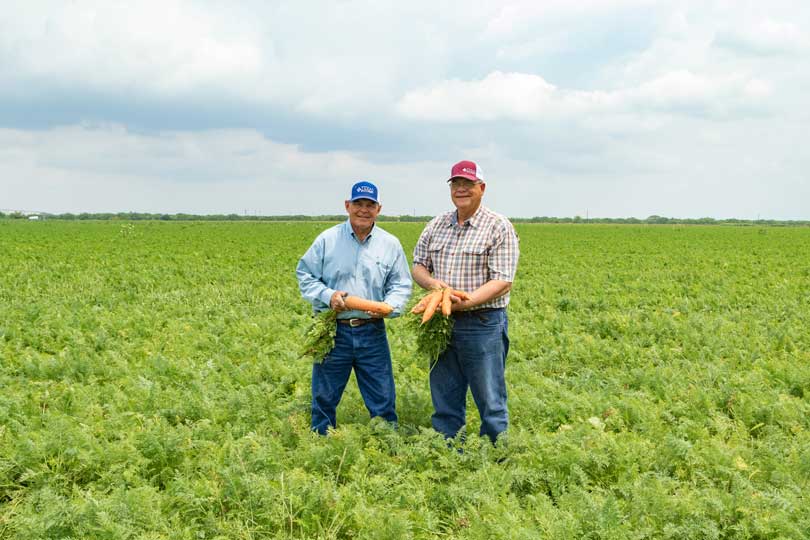By Jennifer Dorsett
Field Editor
The southernmost tip of Texas, usually known as the Rio Grande Valley, is sometimes dubbed “The Magic Valley.” And for good reason.
“Magic things happen,” third-generation farmer and longtime Texas Farm Bureau member Jack Wallace said. “There are so many different crops that you can grow down here—everything from watermelons to carrots to cotton to sorghum to corn. You name it, it’s growing down here. That’s what makes this area special.”
Wallace’s family has grown vegetables just outside Edinburg for more than 60 years. His father, Jack Sr., started contracting with Frito-Lay to grow potatoes in 1964, a tradition that Jack continues.
“My dad once told me that they planted seed in every month but May,” he said with a laugh. “They harvested everything from carrots to cabbage to onions to whatever. You name it, they did it.”
But now, in addition to the potatoes, Wallace grows mainly carrots and watermelons with his business partner, John Prukop.
Prukop’s grandparents were Polish immigrants who first moved to Panna Maria, a large Polish community in Karnes County, before settling for good in Hidalgo County. Prukop’s family grew grain and cotton, and Prukop raised farrow-to-finish pigs when he was growing up.
Their family farms aren’t too far apart. Generations of Wallace and Prukop kids attended school together, forging a path from friendship to business partners.
Like peas and carrots, as the saying goes.
“Jack called me about six or seven years ago and wanted to partner up and grow watermelons as a rotational crop in his potato business,” Prukop said. “We started this partnership growing watermelons, and we migrated to these other crops like carrots. They just fit and the rotation’s good for them.”
Prukop now lives in Bishop, near Kingsville. He said it’s been advantageous to put his family farm into production with Wallace due to economies of scale. Using the same equipment and labor allows them to be more successful as partners than individuals.
Wallace and Prukop grow carrots for three major customers: Campbell’s, Gerber and PictSweet.
“In our carrot production, we grow ‘slicers’ and ‘dicers,’” Wallace said. “Slicers are a carrot typically harvested in about a 90-day period. The requirements are that they don’t get any larger than an inch-and-a-quarter in diameter. So we’ve really got to watch, because a carrot will tend to want to grow pretty quick when the conditions are right. The dicers, we want them to get as big as they can.”
The subtropical climate and soil type of Hidalgo County are ideal for carrot production. The sandy loam soil drains quickly and is just loose enough to allow root vegetables to grow freely.
The tiny seeds are planted in late September or early October, and then it takes around 150 days for the crop to grow.
“Farming is being able to see the hand of God every day,” Wallace said. “When you see how small a carrot seed is, then to see it grow into a large carrot…it’s just a miracle to me how all that works.”
Prukop also has an analogy for the seeds.
“I call seeds little promises, because when you go plant these things, you know that there’s a promise from that seed to do all she can genetically to create what you want her to create,” he said. “When they’re in the bag, they’re little promises. They promise to show up at harvest.”
And the promised fruit of their labor lends itself perfectly to different uses at different times in the growth cycle.
Beginning in January, the smaller “slicer” carrots are harvested for PictSweet. The carrots are washed and sliced on a diagonal before being packaged by the company for the frozen foods aisle at the grocery store.
Harvest continues through May, with the larger carrots at the end of harvest season going to Campbell’s and Gerber as “dicers.” These carrots are cleaned, finely diced and steamed to be used as an ingredient in soups or baby food.
The harvesting is done one row at a time by a specialized machine that pulls the carrots from the ground and “crowns”—or cuts off—the greens and top of the carrot. A tractor pulling a buggy moves alongside the combine, collecting the crowned carrots.
Once the buggy is full, the bin is dumped into a waiting semi-truck trailer. When the trailer is full, the truck heads to


where can I buy 50# bags of carrots for my horses